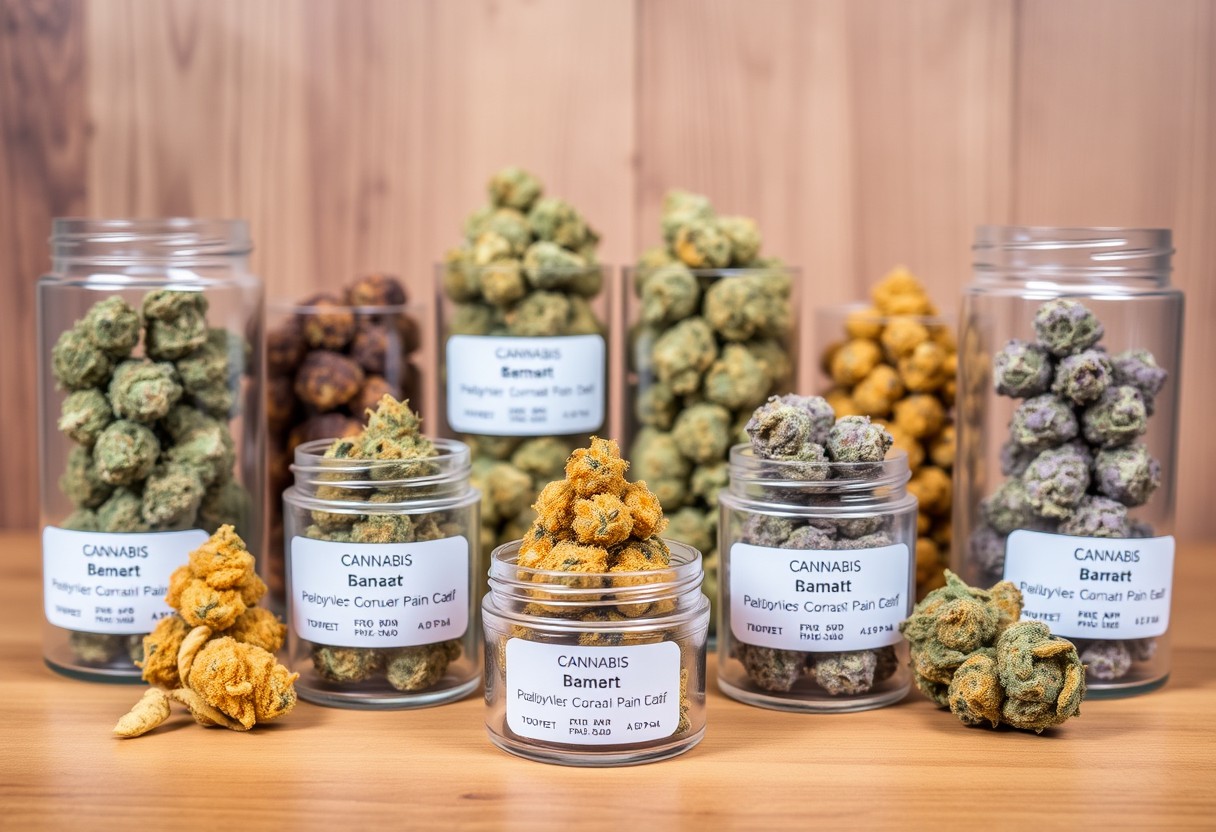Finding Relief – A Review Of The Best Strains For Pain Available Today

It’s imperative for you to explore the best cannabis strains that can effectively alleviate your pain. With countless options available, knowing which strains offer fast-acting relief and minimal side effects can significantly improve your quality of life. In this post, we will provide an in-depth review of the top strains currently available, focusing on their unique properties and benefits for pain management. Whether you’re dealing with chronic pain or temporary discomfort, you can find the right strain to suit your needs and help you find the relief you deserve.

Key Takeaways:
- Strain Selection: The review emphasizes that different cannabis strains have unique properties that can cater to various types of pain relief, highlighting the importance of choosing the right strain for individual needs.
- Indica vs. Sativa: It discusses the differences between Indica and Sativa strains, noting that Indicas are generally more effective for chronic pain and inflammation, while Sativas may be preferable for acute pain.
- THC and CBD Ratios: The article suggests considering THC to CBD ratios, as strains with balanced ratios can provide effective pain relief with a minimized psychoactive experience, appealing to various users.
1. Indica strains often provide deep muscle relaxation.
2. Sativa strains may enhance mood while easing discomfort.
3. Hybrid strains offer balanced relief for varied pain types.
4. CBD-rich strains reduce inflammation without psychoactive effects.
5. THC-dominant strains can deliver potent pain management relief.
6. Individual responses vary; experimentation is crucial for effectiveness.
Understanding Pain: Types and Causes
The understanding of pain is vital for identifying the right treatment. Pain can be categorized into different types based on duration and causes which include:
| Type | Causes |
|---|---|
| Acute Pain | Injury, surgery, or illness. |
| Chronic Pain | Conditions like arthritis, fibromyalgia, or nerve damage. |
| Neuropathic Pain | Nerve injuries or dysfunction. |
| Psychogenic Pain | Emotional distress or psychological factors. |
| Referred Pain | Pain felt in a different area from its origin. |
The perception of pain varies significantly and understanding your specific pain type can aid in more effective management.
Acute Pain
For acute pain, this type typically arises from a sudden injury and lasts a short duration. You may experience it due to falls, fractures, or surgical procedures. Acute pain serves as a warning signal, prompting you to seek immediate attention and care.
Chronic Pain
Types of chronic pain persist over time, often lasting for months or even years. You may deal with constant discomfort, affecting your daily life and emotional well-being.
For instance, chronic pain conditions, such as arthritis or fibromyalgia, can significantly impair your quality of life. The persistent nature of these pains may lead to severe complications, including depression and anxiety. Understanding the root cause is critical for effective treatment, as mismanagement can exacerbate pain, while the right approach may lead to improved outcomes and a better understanding of your body.
The Role of Cannabis in Pain Management
Clearly, cannabis has emerged as a significant player in the field of pain management. Many individuals turn to marijuana for relief from chronic pain conditions, discovering that certain strains can offer both therapeutic benefits and relaxation. For insights into the Best Hybrid Weed Strains to Try for Pain Relief & Relaxation, it’s important to explore the wide range of compounds in cannabis that contribute to these effects.
Cannabinoids Explained
An overview of cannabinoids reveals that they are the chemical compounds found in cannabis that interact with your body’s endocannabinoid system. The two most well-known cannabinoids are THC (tetrahydrocannabinol), which is psychoactive and may provide significant pain relief, and CBD (cannabidiol), which is non-psychoactive and known for its anti-inflammatory properties. Understanding these compounds can aid you in selecting the right strain for your personal needs.
How Strains Affect Pain Relief
Management of pain using cannabis heavily relies on the specific strain you choose. Different strains have unique profiles of cannabinoids and terpenes, which influence not only the intensity of relief but also the type of pain you may experience. Some strains may excel in reducing acute discomfort, while others might help with chronic pain levels over time.
Role of the strain in alleviating your discomfort cannot be overstated. The combination of THC and CBD can create a synergistic effect, enhancing pain relief, while terpenes contribute additional benefits such as reducing inflammation or providing muscle relaxation. However, not all strains are suitable for everyone; it’s important to experiment cautiously, as some strains may heighten anxiety or induce unwanted side effects. Ultimately, choosing the right strain requires evaluating your personal experience and symptoms, ensuring you find what works best for your unique pain relief needs.
Top Strains for Pain Relief
Despite the growing number of options for managing pain, finding the right cannabis strain can be a challenge. Each strain offers unique benefits, and it’s important to choose one that aligns with your specific needs. In this section, we’ll explore the top cannabis strains known for their pain-relieving properties, helping you make an informed choice for your relief.
Indica Strains
An Indica strain is often recommended for its relaxing effects, making it ideal for pain relief. These strains are known to provide a soothing experience that helps alleviate chronic pain, muscle tension, and sleep disorders. If you struggle with pain that disrupts your relaxation, Indica strains could be a great option for you.
Sativa Strains
Strains that fall under the Sativa category typically offer a more uplifting experience. While they are less commonly associated with pain relief, certain Sativa strains can be effective for addressing pain, especially when you need to stay productive during the daytime. Their energizing effects help combat fatigue, allowing you to manage pain while remaining active throughout your day.
A Sativa strain might be suitable for you if you experience milder forms of pain and seek relief without sedation. These strains often enhance your creativity and can contribute to a positive mindset, making it easier to cope with discomfort. Look for strains with higher THCV levels; they have been noted for their potential to reduce pain while also providing an energizing effect.
Hybrid Strains
Indica-dominant hybrid strains can offer a balance of pain relief and productivity. By combining the relaxing properties of Indica with the uplifting effects of Sativa, these hybrids can provide an ideal solution for managing chronic pain while allowing you to engage in daily activities.
Another advantage of hybrid strains is their tailored effects; they can be bred to specifically target pain relief while still providing the desired levels of energy and focus. For many, hybrids represent the best of both worlds, allowing you to treat your pain comfortably without sacrificing your daily routine. By selecting a hybrid strain that suits your preferences, you can effectively manage your symptoms and enhance your quality of life.
How to Choose the Right Strain for Your Needs
Now that you’re on the path to managing your pain, it’s vital to know how to choose the right strain for your needs. Understanding different strains, their properties, and how they interact with your body can help you find the most effective relief. Factors such as the strain’s cannabinoid profile, your personal pain levels, and lifestyle preferences play significant roles in your choice.
Factors to Consider
Strain selection is critical for maximizing your relief experience. Here are some key factors to consider:
- Type of Pain: Identify if your pain is chronic or acute.
- THC and CBD Levels: Know your tolerance and preferences.
- Indica vs. Sativa: Understand the effects each type has on your body.
- Other Cannabinoids: Explore additional benefits from terpenes and other compounds.
After weighing these factors, you can better focus on what will work for you.
Consultation with Professionals
On your journey to find the right strain, consulting with professionals can provide critical insights tailored to your unique needs. For instance, a knowledgeable healthcare provider or a licensed cannabis consultant can guide you through various options, considering your medical history, current medications, and overall health status. Engaging with professionals also mitigates the risks of adverse effects, facilitating a safer use of cannabis. Additionally, a professional can help you understand dosage guidelines, ensuring you achieve the desired relief without unknowingly increasing your tolerance or experiencing complications.
Methods of Consumption
Many people seeking relief from pain find that the method of cannabis consumption can significantly affect their overall experience. Each method offers its unique onset time, duration, and potency. Whether you prefer the rapid effects of inhalation or the longer-lasting benefits of edibles, understanding your options will empower you to choose the best approach for your needs.
Smoking and Vaping
To experience quick relief from pain, smoking or vaping cannabis can be an effective method. Inhalation provides rapid onset of effects, typically within minutes, allowing you to manage your discomfort almost immediately. Smoking offers a traditional experience, while vaping is often seen as a cleaner alternative, producing fewer harmful byproducts.
Edibles and Tinctures
Smoking isn’t the only way to find relief; edibles and tinctures offer a discreet and convenient option for those avoiding inhalation. Edibles provide a longer-lasting effect, as they are digested and metabolized. However, their onset can take up to two hours, so it’s crucial to be patient and cautious with dosing. Tinctures, on the other hand, are liquid extracts that you can easily dose with a dropper. They also have a faster onset compared to edibles, offering a balance between smoking and traditional consumption methods.
Tinctures can be particularly beneficial for precise dosing since you control the amount you take. They can be consumed sublingually for quicker absorption or added to food and beverages. While edibles are often delicious and easy to integrate into your routine, it’s crucial to remember that their potency can vary significantly. Always start with a low dose to avoid potential overconsumption and ensure a safe and enjoyable experience.
Legal and Safety Considerations in Cannabis Use
Once again, it’s crucial to approach cannabis use with an understanding of its legal and safety implications. Familiarizing yourself with the laws in your area can help you avoid potential legal trouble. Additionally, considering safety practices, such as sourcing products from reputable dispensaries and understanding the proper dosages, can enhance your experience and efficacy in managing pain. Always stay informed about your local regulations to ensure a responsible and safe journey with cannabis.
Legal Status by Region
The legal status of cannabis varies significantly by region, encompassing a spectrum from complete prohibition to full legalization. You should always research your local laws to understand whether you can legally purchase, possess, and consume cannabis for pain relief or other purposes. Some areas may allow medical use only, while others may have broader recreational allowances. Always stay informed to ensure your compliance and safety.
Potential Side Effects
Side effects of cannabis use can vary based on the strain and dosage used. While many users find relief, you should be aware of potential adverse effects, such as dizziness, dry mouth, or drowsiness, which can impact your daily activities. Moreover, in rare cases, some individuals may experience heightened anxiety or paranoia, especially with high-THC strains. Understanding these risks allows you to make informed decisions about your pain management.
Effects from cannabis can differ depending on individual tolerance, strain, and consumption method. The most important negative effects may include impaired cognitive function and coordination, which can pose risks if you need to drive or operate machinery. However, cannabis can also have positive effects on mood and overall well-being, granting relief from chronic pain. It’s vital to strike a balance, utilizing lower THC strains or combining them with CBD to minimize adverse reactions while still achieving your therapeutic goals. Always monitor how you feel and adjust your dosage or strain choice accordingly.
To wrap up
Taking this into account, understanding the best strains for pain relief can significantly enhance your quality of life. You now have insights into various strains that have proven effective, empowering you to make informed decisions about your pain management. Remember that individual responses may vary, so exploring different options may be necessary. For more detailed information, you can read about what the best cannabis strains for chronic pain are. Your journey to finding relief starts with knowledge and careful consideration.
FAQ
Q: What factors should I consider when choosing a strain for pain relief?
A: When deciding on a cannabis strain for pain relief, consider the following factors:
1. Type of Strain: Indica strains are known for their calming and sedative effects, making them often more effective for chronic pain and insomnia. Sativa strains can provide uplifting effects, which may help with pain management while also improving mood. Hybrid strains can offer a balance of both.
2. Cannabinoid Content: Pay attention to the levels of THC and CBD. THC is psychoactive and can provide significant pain relief, while CBD is non-psychoactive and is often favored for milder pain relief without the high. A strain with a balanced ratio may be ideal for those seeking both effects.
3. Terpene Profile: Terpenes are the aromatic compounds found in cannabis that also play a role in its effects. Some terpenes, such as myrcene and caryophyllene, are believed to possess anti-inflammatory and analgesic properties. Understanding the terpene profile can help in selecting a strain that suits your specific pain relief needs.
Q: Are there any side effects associated with using cannabis strains for pain relief?
A: Yes, while many people experience relief from pain through cannabis usage, there can be potential side effects. Common side effects include:
1. Psychoactive Effects: High THC levels can lead to feelings of euphoria, anxiety, or paranoia in some users, particularly if they are not accustomed to cannabinoid effects.
2. Drowsiness: Indica strains, while good for pain relief, may cause significant drowsiness, which could interfere with daily activities if used during the day.
3. Dry Mouth and Eyes: Cannabis can cause dry mouth (often referred to as “cottonmouth”) and dry eyes due to its effects on bodily hydration. Staying hydrated and using saline drops can help mitigate these effects.
It’s important to start with a low dose and observe how your body reacts, gradually increasing as necessary under the guidance of a healthcare professional.
Q: How can I effectively use cannabis strains for pain management?
A: To effectively use cannabis strains for pain management, consider the following tips:
1. Start Low and Go Slow: Begin with a low dose of cannabis and gradually increase until you find the optimal dosage that provides the desired level of pain relief. This approach helps to minimize the risk of side effects.
2. Consider Delivery Method: There are various ways to consume cannabis, including smoking, vaping, edibles, and tinctures. Each method has different onset times and durations of effects. For immediate relief, inhalation methods are often preferred, while edibles can provide longer-lasting effects, making them suitable for chronic pain.
3. Consult with a Healthcare Professional: It’s advisable to speak with a knowledgeable healthcare practitioner, especially if you have underlying health conditions or are taking other medications. They can provide personalized recommendations and help you navigate the dos and don’ts of cannabis use for pain management.













